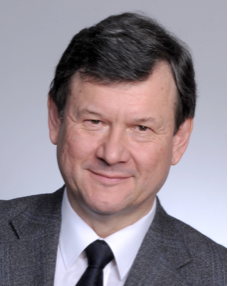|
Prof. Boris B. Straumal Institute of Solid State Physics RAS May 19, 2016 13.00 – 14.30 Room 148 TPOC-3 |
 |
SEMINAR ABSTRACT:The idea that the transition from incomplete to complete surface wetting is a phase transformation was proposed in 1977 by J.W. Cahn, C. Ebner and W.F. Saam. Later this idea was successfully applied for grain boundary (GBs). GB wetting phase transformation proceeds at the temperature Tw where GB energy becomes equal to the energy of two solid/liquid interfaces. Above Tw GB is substituted by a layer of the melt. A second solid phase can also wet the GBs. However, the equilibration in this case is controlled by the diffusion through the solid and takes a long time. The tie-lines of the GB wetting phase transitions appear in the two-phase area of a bulk phase diagram. According to Cahn’s generic phase diagram, the GB wetting tie-lines continue as prewetting (or GB solidus or solvus) lines in the one-phase area a bulk phase diagram. Between GB solidus and bulk solidus, GB contain the equilibrium thin (few nm) layer of a liquid-like phase. Similar thin layers of a GB phase form also between GB and bulk solvus line. GB phases drastically change the properties of polycrystals. In nanograined materials, the presence of GB phases leads to a large apparent shift of solubility lines in bulk phase diagrams. |
SPEAKER INTRODUCTION:Boris Straumal heads the Laboratory of Interfaces in Metals at the Institute of Solid State Physics of the Russian Academy of Sciences (RAS) in Chernogolovka. He is also professor (part-time) at NUST MISiS and guest scientist at the Institute of Nanotechnology of Karlsruhe Institute of Technology in Karlsruhe, Germany. From 1990 Boris Straumal hold the Fellowships of Alexander von Humboldt Foundation in Germany and Heiwa Nakajima Fellowship in Japan, he was guest professor at universities in Neuquen, Argentina, Haifa, Israel, Valencia, Spain, Gothenburg, Sweden, Brno, Czech Republik, Kumamoto, Japan and Cracow, Poland. Boris Straumal was invited researcher at MPI for Metals Research in Stuttgart, Germany and at the Institute of Metallurgy and Materials Science in Cracow, Poland. He published more than 300 papers and has H-factor of 41. He holds a Engineer degree in Metallurgy from the Moscow Institute of Steel and Alloys (currently NUST MISiS), a Ph.D. in Physics and Mathematics from MISiS and a D.Sc. in Physics and Mathematics from the Institute of Solid State Physics, RAS. |